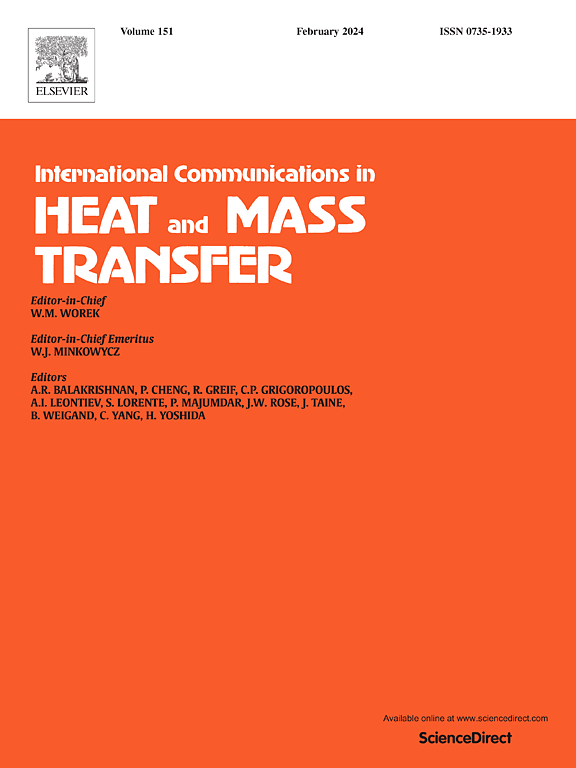u形隔板腔内增强的自然对流:磁场和壁面振荡对纳米封装PCM的协同效应
IF 6.4
2区 工程技术
Q1 MECHANICS
International Communications in Heat and Mass Transfer
Pub Date : 2025-05-09
DOI:10.1016/j.icheatmasstransfer.2025.109051
引用次数: 0
摘要
结合相变材料的热管理系统由于其高能量存储能力和温度控制能力而获得了极大的关注。纳米封装相变材料(NEPCMs)结合磁场控制的最新进展为增强传热应用提供了有前途的解决方案。然而,在复杂的几何结构中,机械振荡和磁场对NEPCM性能的综合影响仍未被探索。本研究研究了一个u形挡板腔内的自然对流,该腔内填充了纳米封装相变材料(NEPCM)水混合物,具有振荡底壁和受倾斜磁场的影响。控制方程采用有限元法求解,运动边界采用任意拉格朗日-欧拉法处理。综合参数研究探讨了瑞利数(103-105)、斯特凡数(0.1-0.9)、熔合温度(0.1-0.9)、纳米颗粒体积分数(0.01-0.04)、振荡幅度(0.07-0.2)、哈特曼数(0 - 20)和磁场角度(0°-90°)对传热性能的影响。结果表明,瑞利数的影响最为显著,Ra从103增加到105时,时间平均努塞尔数增加了129.8%。纳米颗粒体积分数也显著增强传热,当φ从0.01增加到0.04时,努塞尔数增加58.9%。最优振荡幅值为0.07时,最大努塞尔数为1.4377,较大的振荡幅值可使换热效率降低4.5%。这些发现为优化具有相变过程的复杂几何形状的NEPCM纳米流体的热管理系统提供了有价值的见解。本文章由计算机程序翻译,如有差异,请以英文原文为准。
Enhanced natural convection in a U-shaped baffled cavity: Synergistic effects of magnetic fields and wall oscillations on Nano-encapsulated PCM
Thermal management systems incorporating phase change materials have gained significant attention due to their high energy storage capacity and temperature control capabilities. Recent advances in nano-encapsulated phase change materials (NEPCMs) combined with magnetic field control offer promising solutions for enhanced heat transfer applications. However, the combined effects of mechanical oscillations and magnetic fields on NEPCM performance remain unexplored in complex geometries. This study investigates natural convection in a U-shaped baffled cavity filled with a nano-encapsulated phase change material (NEPCM) water mixture, featuring an oscillating bottom wall and subject to an inclined magnetic field. The finite element method is employed to solve the governing equations, with the Arbitrary Lagrangian-Eulerian approach used to handle the moving boundary. A comprehensive parametric study explores the effects of Rayleigh number (103–105), Stefan number (0.1–0.9), fusion temperature (0.1–0.9), nanoparticle volume fraction (0.01–0.04), oscillation amplitude (0.07–0.2), Hartmann number (0−20), and magnetic field angle (0°-90°) on heat transfer performance. Results show that the Rayleigh number has the most significant impact, increasing the time-averaged Nusselt number by 129.8 % as Ra rises from 103 to 105. Nanoparticle volume fraction also significantly enhances heat transfer, with a 58.9 % increase in Nusselt number as ϕ increases from 0.01 to 0.04. The optimal oscillation amplitude of 0.07 achieves a maximum Nusselt number of 1.4377, while larger amplitudes reduce heat transfer efficiency by up to 4.5 %. These findings provide valuable insights for optimizing thermal management systems utilizing NEPCM nanofluids in complex geometries with phase change processes.
求助全文
通过发布文献求助,成功后即可免费获取论文全文。
去求助
来源期刊
CiteScore
11.00
自引率
10.00%
发文量
648
审稿时长
32 days
期刊介绍:
International Communications in Heat and Mass Transfer serves as a world forum for the rapid dissemination of new ideas, new measurement techniques, preliminary findings of ongoing investigations, discussions, and criticisms in the field of heat and mass transfer. Two types of manuscript will be considered for publication: communications (short reports of new work or discussions of work which has already been published) and summaries (abstracts of reports, theses or manuscripts which are too long for publication in full). Together with its companion publication, International Journal of Heat and Mass Transfer, with which it shares the same Board of Editors, this journal is read by research workers and engineers throughout the world.

 求助内容:
求助内容: 应助结果提醒方式:
应助结果提醒方式:


